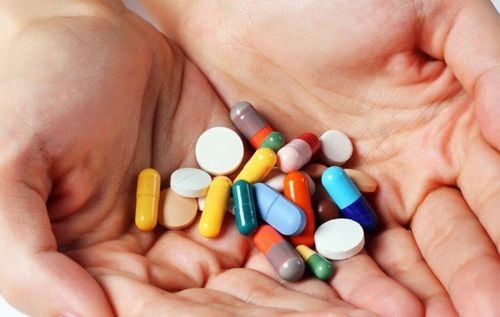This is an automatically translated article.
Liver abscess is a collection of pus in the liver caused by infection with amoeba, bacteria or fungi, which leads to the formation of a solitary pus-filled fovea and many scattered pus-filled foci in the liver. This condition is very common in tropical countries, including Vietnam. So is liver abscess dangerous and what methods are used to diagnose and treat this disease?
1. What is a liver abscess?
1.1 Definition Liver abscess is a condition in which liver cells are damaged and pus-filled foci form in the liver, which will form a solitary pus-filled fovea and many scattered pus-filled foci in the liver.
1.2 Classification Liver abscesses are classified based on the two most common causes:
Amoeba liver abscess Bacterial liver abscesses: Escherichia coli, Bacteroides strains, Klebsiella pneumoniae, Streptococcus strains,... The most common are Escherichia coli and Klebsiella pneumoniae. 1.3 Pathway of entry Pathogens Pathogens such as bacteria and amoebae will follow the following routes to enter the liver:
Biliary tract: Some patients have bacterial infection, cholangitis or biliary obstruction. lead to liver abscess. Portal vein: The pathogens in the intestinal tract follow the portal vein to the liver. Hepatic arteries and systemic lymphatics: In some patients with systemic infection, lymphadenitis, sepsis... Pathogens from extrahepatic or even intrahepatic foci of infection will go away. through the lymphatic or hepatic artery to cause liver disease.
2. Diagnosis of liver abscess
2.1 Clinical symptoms Amoebic liver abscess
History: Patient emigrated or traveled in endemic areas. Fontan's triad: Fever, right upper quadrant pain, hepatomegaly and tenderness. Fever: The first symptom that appears, ranging from mild to severe, with sweating and tachycardia. Right upper quadrant pain: Usually pain or tenderness in the right upper quadrant, moderate to severe, pain spreading to the right shoulder, dull and persistent. Enlarged liver: The liver is usually large, smooth surface, obtuse border, painful pressure, pressing on the patient's intercostal space can cause sharp pain. Other less common symptoms include jaundice, peritonitis, and pericardial rub. Bacterial liver abscess
Dull right lower quadrant pain, possibly with biliary stone-like colic. High fever, shivering, can reach 39-40 degrees Celsius. The liver may be enlarged and painful on examination. Weight loss Jaundice Loose stools, loss of appetite, fatigue. 2.2 Subclinical Amoebic liver abscess
Hematology: WBC may increase, CRP may increase, erythrocyte sedimentation time increases. Serum test: ELISA reaction is valuable in the diagnosis of amoeba-induced liver abscess with high sensitivity and specificity. In the event of a negative serological reaction, the test should be repeated in 1 week. Ultrasound: The lesion is hypoechoic, round or oval, well demarcated, single or multifocal. If the pus is thinner, the image will be more muted or empty. Chest X-ray: Right diaphragm is pushed up, has poor mobility, 80% of patients may have right pleural effusion. Abdominal computed tomography (CT - scan): Helps diagnose the location of the abscess and differentiate it from other lesions such as liver cancer. Aspiration of the abscess: When the diagnosis is uncertain or in the case of a liver abscess about to rupture. There is dark chocolate brown pus, odorless, pus culture can see amoeba and no bacteria. Bacterial liver abscess
Hematology: WBC increased, mainly neutrophils increased, erythrocyte sedimentation time increased, CRP and Procalcitonin increased. Aspiration of abscess with pus culture or blood culture: In most cases, bacteria are found (positive). Imaging tests: Ultrasound will show a hypoechoic mass or mixed echoes in cases where the abscess has not completely turned into pus. CT-scan or MRI of the abdomen helps to diagnose the location of the abscess, and at the same time to differentiate it from other lesions in the liver and biliary tract.
3. Can liver abscess be cured?
Today, with the rapid advancement of medicine, liver abscesses, even caused by amoeba or pus-causing bacteria, can be cured by many different methods such as using antibiotics, aspiration aspiration. pus and drain the pus out.
3.1 Medical treatment Amoeba liver abscess
First choice
Tinidazole orally 2 g daily, for 3 days. Or: Metronidazole 750 mg orally 3 times/day (or 500 mg IV every 6 hours), for 10-14 days.
Plus: Diloxanide furoate 500 mg orally 3 times a day, for 10 days. Or: Paromomycin 10 mg/kg orally 3 times a day for 7 days.
Or: Iodoquinol 650 mg orally 3 times a day, for 7 days.
Alternative medicine
Dehydroemetin or Emetine 1 mg/kg subcutaneously or subcutaneously or intramuscularly/day x 8-10 days. Then: Chloroquine 500 mg orally twice a day for 2 days, then 500 mg/day for 21 days. Plus: Diloxanide furoate 500 mg orally 3 times a day for 10 days. Or: Paromomycin 10 mg/kg orally 3 times a day for 7 days.
Or: Iodoquinol 650 mg orally 3 times a day, for 7 days.
Amoebic drugs in the form of cocoon in the intestine: Take Intetrix inflammatory form, for 7-10 days. Add antibiotics if there is a bacterial superinfection. Bacterial liver abscess
First choice antibiotic
Ampicillin - sulbactam intravenous infusion 1.5 - 3 g every 6 hours. Or: Piperacillin-tazobactam 4.5 g IV every 6 hours. Or: Cefoperazone -sulbactam 2 g IV every 12 hours. Or: Ceftriaxone intravenous infusion 2-4 g / time / day. Or: C eftazidime intravenous infusion 1 - 2 g / time every 12 hours. Or: Cefepim intravenous infusion 1 - 2 g / time every 12 hours. Or: Gentamycin IM or slow IV dilution 80 mg every 8 hours. Or: Amikacin intramuscularly or diluted intravenously slowly 5 mg/kg every 8 hours. Or: Tobramycin IM or dilute intravenously 1 mg/kg every 8 hours. Or: Aztreonam 1-2 g every 12 hours. In combination with Metronidazole intravenous infusion 500 mg every 8 hours if the antibiogram shows anaerobic bacteria infection.
Alternative antibiotic options:
Ciprofloxacin 500 mg orally or IV every 12 hours.
Or: Levofloxacin 500 mg orally or IV every 12 hours. Or: Moxifloxacin 400 mg orally or IV every 24 hours. In combination with Metronidazole intravenous infusion 500 mg every 8 hours if the antibiogram shows anaerobic bacteria infection.
In case the patient does not respond to other antibiotics above, or the patient has severe symptoms:
Meropenem IV infusion 1 g every 8 hours. Or: Imipenem - Cilastatin IV infusion 1 - 2 g every 12 hours.
Or: Doripenem 0.5 g IV every 8 hours.
The duration of treatment can be extended from 2 to 4 weeks depending on the patient's response.
Aspiration and drainage of the abscess
Indications for aspiration of the abscess in the following cases:
The disease or cause of liver abscess has not been accurately diagnosed. Large abscesses (diameter ≥ 5 cm): Can be drained locally and irrigated daily. The patient did not respond to treatment for 3 to 5 days. Risk of abscess rupture. The patient was diagnosed more than 3 months late. Prevent rupture of left lobe liver abscess into the pericardium. Note: The aspiration and drainage of the abscess need to be combined with the use of therapeutic drugs.
Liver abscess is a fairly common disease in our country and thanks to the advancement of science and technology, the diagnosis and cure of liver abscess is no longer a difficult problem. However, in order to improve the effectiveness of treatment and prevent complications of liver abscess, patients and their families need to detect symptoms early and go to medical facilities for examination. examination and treatment by specialists.
The Department of Gastroenterology of Vinmec International General Hospital always receives satisfaction and high appreciation from customers by the quality of treatment, medical equipment and patient care services.
Leading modern equipment in Vietnam: High-resolution flexible gastrointestinal endoscope helps detect cancer at an early stage and accurate digestive diseases. American surgical robot has high precision, less invasive, fast patient recovery time. Team of highly qualified doctors: The doctors are well-trained at the leading surgical centers of Vietnam, Korea, Singapore, Japan, with high professional qualifications. Participate in short-term training courses abroad, update the latest techniques and treatment regimens in the world. Diagnosing and treating digestive diseases with the latest technology: Robotic endoscopic surgery with a success rate of up to 95%. Gastrointestinal endoscopy is painless and painless. Comprehensive patient care: Being the first hospital in Vietnam to apply the program of early recovery after surgery (ERAS), which shortens the hospital stay to only 3 - 5. Complication rate, cost of patients is reduced, bringing many benefits to customers.
Please dial HOTLINE for more information or register for an appointment HERE. Download MyVinmec app to make appointments faster and to manage your bookings easily.













